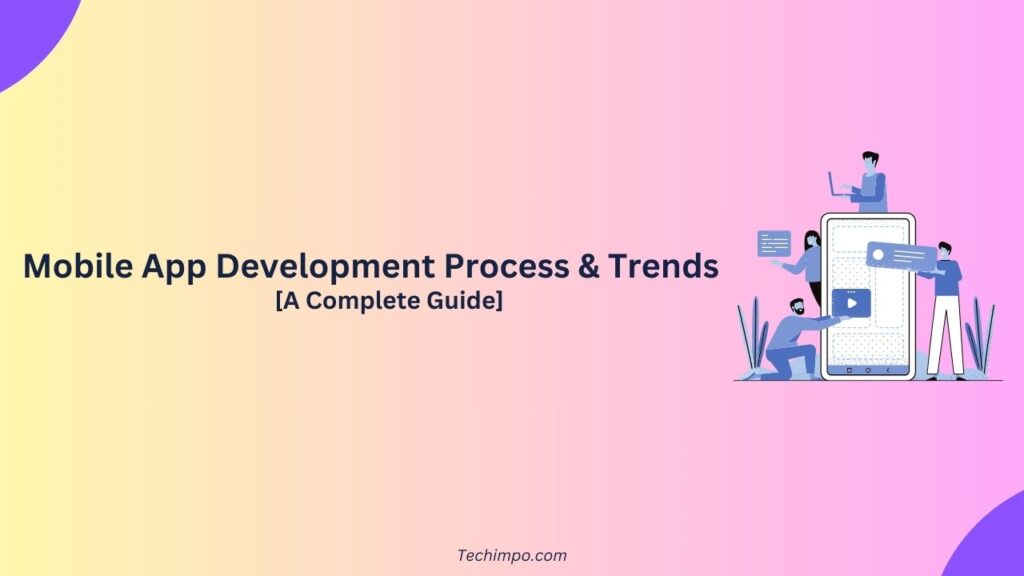There used to be a time when an app being “mobile-friendly” was a thing. But, in 2025, it will not be nearly enough. With people spending more than 4 hours on mobile devices, you must have a mobile-first app development strategy.
Despite this, many online businesses still treat mobile apps as an afterthought. They start building their presence with the web first, then try to adapt functionality to smaller screens. And this is where they take the hit.
A well-thought-out mobile app is a necessity, but why?
- For startups, it is the way to newer audiences and growth avenues.
- For SMEs, it drives customer engagement.
- For enterprises, it fosters brand loyalty and scales operations.
In short, to win today, think mobile-first. This blog post will go over the key steps involved in mobile app development and explore some trends that are guiding this process in 2025.
[Also Read: How to Install An Android App on PC – Best & Easiest Ways]
How to Develop a Mobile App: Mobile App Development Process Steps
Mobile app development requires a structured, step-by-step approach.
1. App Ideation and Market Research
Start with the planning phase – This is where you already have an app idea. Think further and determine the problem(s) it will solve and for whom. Look for similar apps existing in the market and see what you can offer differently.
2. Feature and Scope Definition
Based on the above analysis, identify core features – Shortlist critical ones that will be included later on in a minimum viable version (MVP) of your app. This will help gather initial feedback.
3. User-Centric UI/UX Design
Once you have a basic version, it’s time to design – Map out user interactions, create detailed wireframes, and build prototypes, keeping simplicity and usability in mind.
4. Mobile App Development
Time to build your mobile app – Follow an agile and iterative development process. Document regularly and ensure clear communication within the development team (developers, UI/UX designers, and testers) and with stakeholders.
5. Testing and QA
Test your app thoroughly – Conduct end-to-end testing, including performance & load, functional, API, security, accessibility, and usability.
6. Deployment and Go-Live
After building a mobile app, it’s time to deploy it in a real environment – Prepare for the App Store/Play Store launch. Make sure to check compliance with all platform-specific mobile app guidelines to avoid delays and rejections.
How AI/ML Has Impacted Mobile App Development?
The mobile app development process discussed above was standard until a few years back, especially prior to AI/ML’s proliferation in almost every process, every industry. With AI/ML in the picture, the process has significantly changed—for better or for worse (we’ll explore this in the later sections).
In the app ideation as well as market research phase, AI/ML can help you analyze your target audience’s preferences plus pain areas using data on previous downloads, app usage, taps on screen, etc. When you have this information, you can easily determine the issues they face, plus the features they are looking for.
The design phase, after that, focuses on optimizing the UI/UX. AI tools process the real-time user interaction data that includes user taps, session durations, navigation, etc, and then recommend interface adjustments.
Many UI/UX designers also use AI-integrated tools as they can convert sketches and wireframes into working UI components, and that actually speeds up the whole design process.
AI’s utility in the core mobile app development process is on record. By automatically suggesting pre-written templates along with relevant code snippets, AI-integrated tools such as GitHub Copilot and Tabnine streamline and accelerate coding.
A recent study from GitHub indicates that, according to 47% of surveyed developers, AI tools freed up significantly more time for designing new, consumer-focused solutions.
In QA and testing, AI tools such as Selenium, Appium, and SonarQube have automated code scanning to identify vulnerabilities, bugs, and performance issues. AI can also help with deployment.
Tools like Fastlane have AI capabilities that can help you create platform-specific versions (iOS, Android) quickly. They can also release beta builds before launching the final versions on the App Store/Play Store.
Post-deployment, AI-integrated analytical tools simplify monitoring by observing user behavior, tracking app performance, and generating detailed crash reports.
Critical Decisions You Need to Make Before Developing a Mobile App in 2025
As mobile app development trends and best practices continue to evolve, you, as a business owner, must make some critical decisions that impact both the timeline and the functionality of your apps. Let us look at some of them.
– Cross-Platform vs Native Development
Deciding whether you want a hybrid app (that works on all platforms) or a native (platform-specific) app is one of the most critical decisions.
Cross-platform/hybrid apps are developed using frameworks like Flutter and React Native, using a single codebase and some additional platform-specific code segments. With this, you can really reduce the time taken as well as your expenditure, making it ideal if you are on a tight budget.
But, at the same time, cross-platform apps sometimes come across performance limitations and offer fewer device-specific optimizations.
On the other hand, when you build a native mobile app, you will work on separate codebases for each platform—iOS (using Swift) and Android (using Kotlin or Java).
While it is a fool-proof mobile app development strategy, it takes double the time, development effort, and costs. Thus, it is more ideal for those without budget constraints.
– DIY Mobile App Development Using Low-Code/No-Code vs Professional Development
Self-serve Low-Code/No-Code platforms (like Appgyver and OutSystems) that enable users to build mobile apps without deep technical expertise have also added to the confusion: whether to create an app on your own or outsource mobile app development services.
The main advantages of working with a DIY mobile app development tool/platform are a quick TAT and cost-effectiveness. You do not need a dedicated team of technically proficient developers. However, this approach comes with a very limited customization scope.
Conversely, when you outsource mobile app development services, you get access to a dedicated team and benefit from a tried-and-tested process. Expert developers can customize your mobile app, building it with the desired features from scratch.
This approach offers a better ROI in the long term, with easier scaling and integration with emerging technologies. However, it does require a high upfront investment and takes longer.
The above discussion, of course, is valid for those not having an internal team of app developers.
Other Emerging Mobile App Development Trends to Watch in 2025 and Beyond
Mobile apps are evolving, and with AI in the picture, they will continue to do so. Consequently, several key trends are shaping this industry, and, in fact, some new advancements are taking shape even as you read this blog post.

Nevertheless, let us discuss some of the key discussions around mobile app development that are relevant in 2025 and beyond.
1. Security by Design
With online threats and scams at an all-time high, security is a top priority. This is why many organizations are adopting a security-by-design approach. With this approach, they are incorporating code checks and vulnerability assessment, embedding security protocols, and encryption in the early stages of mobile app development.
2. User-Centricity of UI/UX Designs
Another key mobile app development trend is the shifting of preferences toward more accessible and inclusive interfaces. This is because today’s mobile apps are expected to be easy to navigate and workable for all users, including those with varying disabilities.
As a result, many businesses include screen readers, AI voice assistants, and multiple contrast options as a standard practice.
Additionally, they are making their mobile apps more inclusive by taking cultural nuances and educational backgrounds into consideration. Consequently, the apps are reaching a wider range of people, leading to higher adoption and retention rates.
3. Localization and Cultural Adaptation
A global presence also requires local adoption, and this is where mobile app localization helps. Localization goes beyond simply translating text and extends to adapting content as well as functionality to meet local/regional expectations.
For example, incorporating right-to-left languages like Arabic also requires tweaks to the layout. Similarly, the payment systems you integrate must comply with locally used methods like mobile wallets or cash-on-delivery.
Airbnb is a great example. They have excelled in mobile app localization, providing consistent yet unique functionality in over 220 regions and in 60+ languages. Consequently, it has garnered a global reputation and a market capitalization of more than US$ 83 bn as of late 2024.
4. Emphasis on Sustainability and Eco-Friendly Mobile App Development
People (both users and businesses) have become more conscious about their societal and environmental footprint. Moreover, with ESG (environmental, societal, and governmental) reporting becoming a mandatory practice in many regions, such as Europe, even businesses are refining their development strategies.
They have shifted their focus to making apps and systems more energy efficient by minimizing data storage, reducing energy consumption, and streamlining app performance.
In addition to this, organizations are shifting to a cloud-first model, reducing hardware requirements in their infrastructure while also bringing down e-waste.
Final Words
The mobile app industry is constantly growing and evolving, with new technologies and user expectations emerging all the time. This means there will always be something new to learn and adapt to, and mobile app development is no exception.
Whether it is picking the right way to build your app, using AI in your process, integrating security, or making sure the app works well for people everywhere, there is a lot to figure out.
We have discussed the key steps of building a mobile app and some of the trends you’ll want to keep an eye on in 2025. Even if all this feels overwhelming, you’re not alone.
Many businesses struggle to focus on their mobile app development process while also juggling other tasks. That’s why working with a trusted app development company can make a real difference. The goal is to build apps that people love and drive growth for your business.




